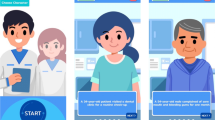Abstract
Objective
We sought to evaluate a set of flash cards to teach about lesions of the jaws and maxillary sinuses.
Methods
We placed illustrations of 30 diseases of the jaws and maxillary sinuses on the front of the cards (7 cm × 5 cm). On the backs of the cards, a description of the radiological findings and the corresponding QR code for each disease were printed. Each QR code was linked to a website where actual X-ray images of the lesion could be viewed. Students and radiologists in training could easily access the website by scanning the QR code with a handheld device. The evaluation of the system by students was quite favorable and its utilization rate was high. After a 6-month trial, we conducted a questionnaire. The subjects were 94 fourth-year students at our college, and the questionnaire was anonymous.
Results
The evaluation of the system by students was quite favorable and its utilization rate was high.
Conclusions
The learning content of our learning cards with QR codes was well received by students and was highly useful.









Similar content being viewed by others
References
Ozer MA, Govsa F, Bati AH. Web-based teaching video packages on anatomical education. Surg Radiol Anat. 2017;39(11):1253–61.
Pugh CM, Watson A, Bell RH, et al. Surgical education in the internet era. J Surg Res. 2009;156(2):177–82.
Weiner CK, Skålén M, Harju-jeanty D, et al. Implementation of a web-based patient simulation program to teach dental students in oral surgery. J Dent Educ. 2016;80(2):133–40.
Debate RD, Severson HH, Cragun D, et al. Randomized trial of two e-learning programs for oral health students on secondary prevention of eating disorders. J Dent Educ. 2014;78(1):5–15.
Nielsen JP, Clark TJ. Radiologist-centered decision support applications. J Am Coll Radiol. 2016;13(9):1083–7.
Kwon HB, Park YS, Han JS. Augmented reality in dentistry: a current perspective. Acta Odontol Scand. 2018;76(7):497–503.
Mogali SR, Vallabhajosyula R, Ng CH, Lim D, Ang ET, Abrahams P. Scan and learn: quick response code enabled museum for mobile learning of anatomy and pathology. Anat Sci Educ. 2019;12(6):664–72.
Traser CJ, Hoffman LA, Seifert MF, Wilson AB. Investigating the use of quick response codes in the gross anatomy laboratory. Anat Sci Educ. 2015;8(5):421–8.
Downer T, Oprescu F, Forbes H, et al. Enhancing nursing and midwifery student learning through the use of QR codes. Nurs Educ Perspect. 2016;37(4):242–3.
Sobhani NC, Fay EE, Schiff MA, Stephenson-famy A, Debiec KE. Randomized trial of smartphone-based evaluation for an obstetrics and gynecology clerkship. J Surg Educ. 2018;75(4):1006–133.
Jamu JT, Lowi-jones H, Mitchell C. Just in time? Using QR codes for multi-professional learning in clinical practice. Nurse Educ Pract. 2016;19:107–12.
Author information
Authors and Affiliations
Corresponding author
Ethics declarations
Conflict of interest
All authors declare that they have no conflict of interest.
Human rights statements and informed consent
All procedures followed were in accordance with the ethical standards of the responsible committee on human experimentation (institutional and national) and with the Helsinki Declaration of 1964 and later versions. Informed consent was obtained from all students for being included in the study.
Animal rights statements
This study did not use any animal.
Additional information
Publisher's Note
Springer Nature remains neutral with regard to jurisdictional claims in published maps and institutional affiliations.
Rights and permissions
About this article
Cite this article
Toyohiro, K., Yuki, N., Shoko, Y. et al. Development of flash cards to teach about lesions in the jaws and maxillary sinuses. Oral Radiol 37, 231–235 (2021). https://doi.org/10.1007/s11282-020-00435-0
Received:
Accepted:
Published:
Issue Date:
DOI: https://doi.org/10.1007/s11282-020-00435-0




